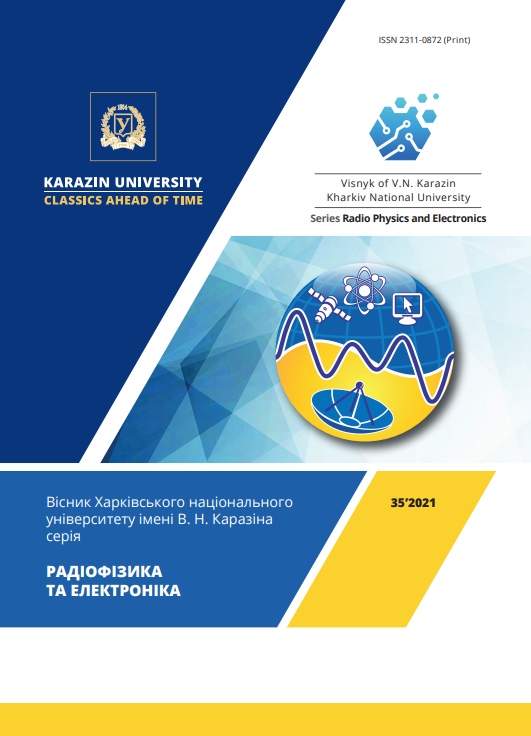Increasing power of generator on nonlinear magnetic nanostructure
Abstract
Background: One of the most promising areas of development of modern electronics is the creation of spintronic devices, which should replace the traditional semiconductor elements. The use of electron spin as a carrier of information in magnetic nanostructures can radically change modern life.
Objectives: The aim of this work is to find ways to increase the power of the generator on the magnetic nanostructure by changing its electrical circuit and more optimal external electromagnetic parameters that affect the state of electrons in the studied layered structure.
Materials and methods: The solution of this problem is carried out by numerical simulation of the magnetic nanostructure using a specially created micromagnetic simulator, which implements an algorithm for the simultaneous solution of the system of Maxwell and Landau-Lifshitz-Hilbert equations. The solution of such a complex problem is accelerated by the use of a quasi-static approximation in solving the system of Maxwell's equations, which is justified by the small size of the calculation area compared to the depth of the skin layer. Further calculations of the electrodynamic system are performed using the finite element method. To obtain the best frequency and energy parameters of the generator, it is proposed to introduce a resonant circuit to the schematic diagram of the studied generator, which is excited by short nanosecond pulses.
Results: A scheme of a generator on a magnetic nanostructure containing a resonator with concentrated parameters is proposed, and a system of nonlinear integro-differential equations with respect to electric currents is obtained in general. Numerical calculation of this system includes, in addition to the calculation of the scheme, also the modeling of a nonlinear electrodynamic structure by the finite element method. The energy and spectral characteristics of the studied generator are obtained. The search for the optimal values of the geometric parameters of the nanostructure and the magnitude of the external longitudinal magnetization is carried out.
Conclusions: Due to the complex nature of nonlinear processes in the magnetic nanostructure, the use of an external resonator, which could improve the spectral parameters of the generated current, did not give a noticeable improvement. The influence of the value of the external magnetization on the output power of the generator is complex and nonlinear, but, in general, a decrease in the level of magnetization leads to a significant decrease in power. It is established that the thickness of the magnetic layer of 6 nm is optimal for improving the energy characteristics of the generator.
Downloads
References
https://doi.org/10.1109/TED.2020.2965403
2. Fischbacher T, Franchin M, Bordignon G, Fangohr H. A systematic approach to multiphysics extensions of finite-element-based micromagnetic simulations: Nmag. IEEE Trans. Magn. June 2007;43(6):2896–2898. http://dx.doi.org/10.1109/TMAG.2007.893843
3. Recio G, Estebanez C. Micromagnetic modeling on magnetization dynamics with lossy magnetic material in thin film heads by FDTD calculations. Appl. Comput. Electrom. Sept. 2012;27(9):717–725.
4. Lopez-Diaz L, Aurelio D, Torres L, Martinez E, Hernandez-Lopez M.A, Gomez J, Alejos O, Carpentieri M, Finocchio G, Consolo G. Micromagnetic simulations using Graphics Processing Units. J. Phys. D: Appl. Phys. July 2012;45(32):323001. https://doi.org/10.1088/0022-3727/45/32/323001
5. Vansteenkiste A, Wiele BV. MuMax: a new high performance micromagnetic simulation tool. J. Magn. Magn. Mater. Nov. 2011;323(21):2585–2591. https://doi.org/10.1016/j.jmmm.2011.05.037
6. Chang R, Li S, Lubarda MV, Livshitz B, Lomakin V. FastMag: Fast micromagnetic simulator for complex magnetic structures (invited). Journal of Applied Physics. 2011:;109:07D358. https://doi.org/10.1063/1.3563081
7. Couture S, Chang R, Volvach I, Goncharov A, Lomakin V. Coupled finite-element micromagnetic-integral equation electromagnetic simulator for modeling magnetization-eddy currents dynamics. IEEE Transactions on Magnetics. December 2017;53(12). https://doi.org/10.1109/TMAG.2017.2745470
8. Volvach I, Kuteifan M, Lubarda MV, Lomakin V. Circuit-Integrated Micromagnetic Modeling of MRAM Devices. 62-nd Annual Conference on Magnetism and Magnetic Materials. Pittsburgh, Pennsylvania. Nov 6-10, 2017. p. 658.
9. Kuteifan M, Volvach I, Lomakin V. Forward Flux Sampling Method with Spin Transfer Torque for the Calculation of Thermal Relaxation Times of Free Layers. 62-nd Annual Conference on Magnetism and Magnetic Materials. Pittsburgh, Pennsylvania. Nov 6-10, 2017. p. 659.
10. Volvach I, Kuteifan M, Marko V, Lubarda MV, Lomakin V. Circuit-Integrated Micromagnetic Modeling of MRAM Devices. Special joint poster session on MRAM. IEEE 63-rd International Electron Devices Meeting IEDM. San Francisco, California. Dec 4–7, 2016.
11. Volvach I, Kuteifan M, Lubarda MV, Lomakin V. Integrating FastMag with NGSPICE Framework. Research Review & Advisory Council Meeting (CMRR). San Diego, California. May 18-19, 2017. p. 19.
12. Volvach IS, Dumin OM, Plakhtii VA, Pryshchenko ОА. Oscillation generator on a nonlinear magnetic nanostructure. Visnyk of V.N. Karazin Kharkiv National University, series “Radio Physics and Electronics”. 2018;28:34–43. (In Ukrainian)




